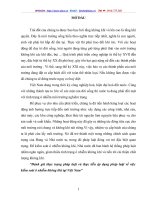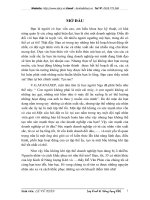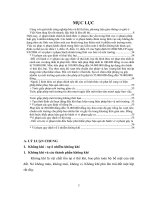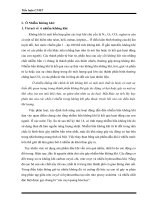POWERPOINT VỀ Ô NHIỄM KHÔNG KHÍ
Bạn đang xem bản rút gọn của tài liệu. Xem và tải ngay bản đầy đủ của tài liệu tại đây (1.22 MB, 13 trang )
This is your
presentatio
n title
Situation
and Trends
2
Ambient Air
Pollution
Air pollution is a major environmental issue
affecting people across the world. According
to the World Health Organisation (WHO),
more than 2 million people worldwide die
every year from air pollution.
● the population of Asia and the Pacific is
among the most highly exposed to PM2.5
in the world.
3
Indoor Air
Pollution
● Globally, the number of annual
deaths from indoor air pollution has
fallen by more than 1 million since
1990
● This means that despite continued
population growth in recent
decades, the total number of deaths
from indoor air pollution has still
declined.
4
5
Health affected
by air pollution
● Fewer than 8 percent of the region’s people
are exposed to levels of air pollution that
do not pose a significant risk to their health
according to the World Health Organization
(WHO) Guideline.
● WHO estimates that in 2016, some 58% of
outdoor air pollution-related premature
deaths were due to ischaemic heart
disease and strokes
6
Causes
Ambient Air
Pollution
● Common sources of air pollution
are emissions caused by
combustion processes from motor
vehicles, solid fuel burning and
industry
○
○
○
○
○
Urbanization source
Stationary Sources
Mobile Sources
Rural Area Sources
Marine Emissions
8
Household Air
Pollution
● Air pollution is now considered the world's
biggest environmental health threat. Half of
the world's population has no access to
clean fuels or resources, 9 out of 10 people
are inhaling polluted air, and up to 7 million
people are killed each year because of air
pollution.
● The impact of air pollution on human health
is increasingly concerned
9
“
Quotations are
commonly printed as
a means of
inspiration and to
invoke philosophical
thoughts from the
reader.
10
Valuation of air pollution’s effect
on healthcare expenditure
● The analysis involved two steps:
○ Measure the reductions in PM2.5 and ozone
concentration levels throughout the area for our
air quality improvement scenario.
○ Quantify potential spending reductions
11
“
●
China managed to calculate that for every
10 μg/m3 decrease in PM2.5 concentration,
a reduction of 9 billion $ in healthcare
expenditure for air pollution will occur.
●
In order to convert this data into the Asia’s
healthcare expenditure for air pollution, we
will have 2 assumptions.
○
in order to reduce 10 μg/m3 in PM2.5
concentration, Asia as a whole will
need at least 9 billion $.
○
at any level, a 10 μg/m3 decrease in
PM2.5 concentration will always results
in a reduction of 9 billion $ in
healthcare expenditure for air pollution
and vice versa.
12
From the table above, we can calculate the mean level of PM2.5 concentration in Asia is about 21,56
μg/m3. Therefore, follow our function above, we come to conclusion that the healthcare expenditure
for air pollution in Asia is at least 19,5 billion $.
13









